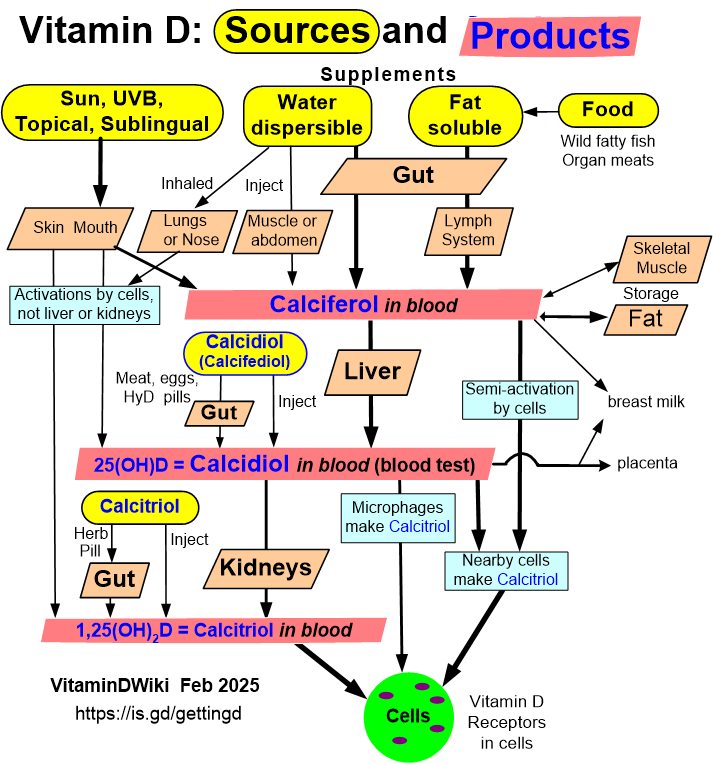Crohn’s Disease risk increased 3 X if inadequate vitamin D level (another form is needed)
The Association of Vitamin D Status with Disease Activity in a Cohort of Crohn’s Disease Patients in Canada
Nutrients 2017, 9(10), 1112; doi:10.3390/nu9101112, Published: 12 October 2017
 ---
1. Gut category listing contains the following
{include}
---
* Crohn's Disease relapse rate of 3 in 8 with 1,000 IU vs 0 in 12 with 10,000 IU of Vitamin D – RCT Feb 2017
* Crohn’s disease helped when vitamin D level raised above 30 ng – RCT Feb 2015
* Crohn's Disease patients normalizing their Vitamin D levels decreased risk of surgery by 44 percent – Aug 2013
* Intestinal absorption of vitamin D – systematic review Aug 2017
* Crohn's disease associated with 7.6X deactivation of Vitamin D receptor – July 2015
---
1. Gut category listing contains the following
{include}
---
* Crohn's Disease relapse rate of 3 in 8 with 1,000 IU vs 0 in 12 with 10,000 IU of Vitamin D – RCT Feb 2017
* Crohn’s disease helped when vitamin D level raised above 30 ng – RCT Feb 2015
* Crohn's Disease patients normalizing their Vitamin D levels decreased risk of surgery by 44 percent – Aug 2013
* Intestinal absorption of vitamin D – systematic review Aug 2017
* Crohn's disease associated with 7.6X deactivation of Vitamin D receptor – July 2015
📄 Download the PDF from VitaminDWiki
Dania Alrefai 1, Jennifer Jones 2, Wael El-Matary 3, Susan J. Whiting 1OrcID, Abdulrahman Aljebreen 4, Naghmeh Mirhosseini 5OrcID and Hassan Vatanparast 1,* OrcID
1 College of Pharmacy and Nutrition, University of Saskatchewan, Saskatoon, SK S7N 5C9, Canada
2 Division of Digestive Care & Endoscopy, Department of Community Health and Epidemiology, Dalhousie University, Truro, NS B2N 5E3, Canada
3 College of Medicine, University of Manitoba, Winnipeg, MB R3T 2N2, Canada
4 College of Medicine, King Saud University, Riyadh 11451, Saudi Arabia
5 Pure North S’Energy Foundation, Calgary, AB T2R 0C5, Canada
- Author to whom correspondence should be addressed.
We determined the association between vitamin D status as 25hydroxyvitamin D [25(OH)D] and disease activity in a cohort of 201 Crohn’s Disease (CD) patients in Saskatoon, Canada over three years. The association between high-sensitivity C-reactive protein (hs-CRP) and 25(OH)D and several disease predictors were evaluated by the generalized estimating equation (GEE) over three time-point measurements. A GEE binary logistic regression test was used to evaluate the association between vitamin D status and the Harvey-Bradshaw Index (HBI). The deficient vitamin D group (≤29 nmol/L) had significantly higher mean hs-CRP levels compared with the three other categories of vitamin D status (p < 0.05). CRP was significantly lower in all of the other groups compared with the vitamin D-deficient group, which had Coef. = 12.8 units lower (95% CI −19.8, −5.8), Coef. 7.85 units (95% CI −14.9, −0.7), Coef. 9.87 units (95% CI −17.6, −2.0) for the vitamin D insufficient, adequate, and optimal groups, respectively. The vitamin D status was associated with the HBI active disease category.
However, the difference in the odds ratio compared with the reference category of deficient vitamin D category was only significant in the insufficient category ( odds ratio = 3.45 , p = 0.03, 95% CI 1.0, 10.8). Vitamin D status was inversely associated with indicators of disease activity in Crohn’s disease, particularly with the objective measures of inflammation.
